Pumps for increasing water pressure: types, how to choose, installation technology + connection diagrams
Low pressure in the water supply can make not only you angry, but also expensive equipment.Agree, both of them simply need to be protected. Such situations mainly depress owners of private houses, but they also happen in apartments connected to centralized networks. How to deal with them?
Pumps to increase water pressure will forever get rid of these troubles. They will provide the operating parameters required for the normal functionality of household appliances. Compact, almost invisible devices will protect your nerves and extend the operating life of the units.
The article presented to your attention details the principles of equipment selection and the rules for its installation. For those wishing to carry out the work themselves or supervise hired plumbers, useful diagrams will help. The information is supplemented by photo selections and videos.
The content of the article:
Pump operation to increase pressure in the network
The problem of low pressure in the water supply system is solved using two types of devices: circulation and self-priming pumps. The former are simpler in design and easier to install into the system.
A conventional circulation pump consists of a rotor, an impeller attached to it and a motor that rotates it all. Usually, if there is water in the system, but its pressure is weak, one or two pumps are enough.

But if water does not flow to the upper floors at all, you will have to install a high-power pumping station with hydraulic tank.Such a device is simply installed as part of the plumbing system in a suitable location. The impeller rotates, giving the water flow additional acceleration.
As a result, the pipes fill with water faster, providing the required level of pressure in the water supply. These are compact, low-power devices designed to solve local problems. Suction pumps have higher performance and a more complex design.
In addition to a suction pump capable of pumping water to a considerable height, the system is also equipped with hydraulic accumulatorequipped with a special membrane.
The operation of this technique is automated and is used pressure switch. Water is first supplied to the storage tank and then enters the water supply, providing the necessary characteristics within the system.
Thus, if a centrifugal pump eliminates a problem in a particular area, then suction equipment is used to regulate the entire water supply in a house or apartment.
Self-priming booster pumps are capable of lifting liquid to a height of up to 12 m, while their power starts from 2 m3/h.
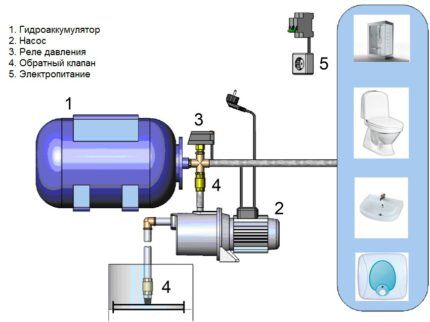
Boosting water pressure the pump works as follows. When the water flow reaches 1.5 cubic meters, the motion sensor petal changes position.
This causes the pump to turn on automatically. When the water flow stops, the pump turns off. This type of equipment is used both in private cottages and in apartment buildings.
It is especially relevant in high-rise residential buildings, where it is impossible to ensure normal water delivery to the upper floors without a special pump for various reasons.Installing one pump or even a special station with increased power can be a real salvation for residents of upper floors.
Sometimes you have to use not one booster pump, but two or more. Owners of houses in which the plumbing system was initially designed with errors sometimes face this need.
In this case, you will have to calculate the cost of reworking the water supply (if such a possibility exists at all) and the cost of installing additional equipment.
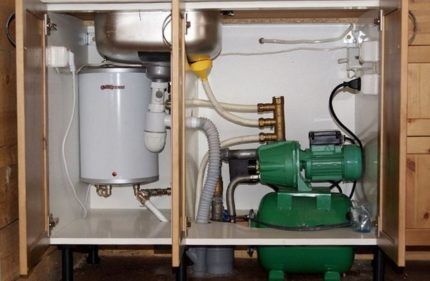
It should be remembered that special types of equipment are designed for pumping hot water. They are made of special heat-resistant materials, so they are more expensive than simpler models designed for contact only with cold water. There are also universal booster pumps that are suitable for both cold and hot water.
Normal power circulation pump small, it consumes less energy than some incandescent lamps.
When it is included in the system, you can achieve an increase in pressure by about 2-3 atmospheres. If a more serious correction of characteristics is required, preference should be given to more powerful equipment.
Circulation pumps have the property of working “at a dead end”, i.e. they do not need to be turned off even if all the taps are closed and no water is drawn from the system. Supply pumps function in approximately the same way to increase water pressure. These devices are similar in design to circulation models.
If such a pump is turned off, water will circulate freely through its body. As soon as power is supplied to the motor, the pump turns on. The impeller begins to rotate and the water pressure in the system increases. If there is a choice between automatic or manual systems, the former is usually preferred.

This type of equipment is more convenient to use and lasts longer because it does not run idle. It makes sense to use a manual pump only in cases where it will be used either very briefly (temporary option) or extremely rarely (in the summer, at the dacha, only on weekends).
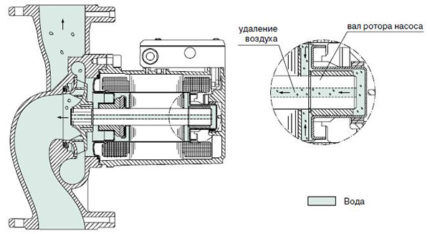
The concept of dry and wet rotor refers to information about the cooling system of the device. In the first case, it is cooled by a flow of air, and in the second, by a flow of pumped water.
A pump with a wet rotor is cheaper, but lasts less due to the negative effects of sediment that accumulates on the working parts during pumping of water. Models with a dry rotor cope with their tasks more efficiently and have a longer service life.
Rules for selecting unit power
The power of the device must be commensurate with the needs of the system. Not enough pressure is bad, but you don't want too much pressure either.
If a pump that is too efficient is selected for the water supply system, the pressure in the system will increase and all its elements will be subjected to unnecessary additional load. This leads to rapid wear and frequent breakdowns.
Stable system water pressure there must be no less than two atmospheres. This is enough for comfortable water procedures, as well as for starting an automatic washing machine.
Although some models are more demanding in terms of operating conditions. For example, if the house has a shower, hydromassage, jacuzzi or other similar devices, the pressure should be higher.
In this case, it is better to increase the pressure in the water supply system to 5-6 atmospheres. Certain types of equipment require even higher performance.
Therefore, the first step before installing a pressure booster pump should be to study the documentation of household appliances. If you plan to purchase any devices in the future, their characteristics also need to be taken into account.
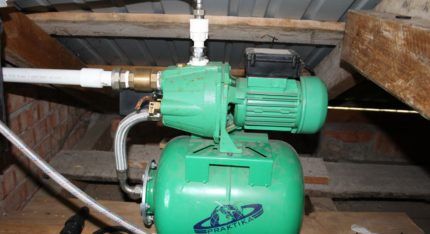
A specialist can make accurate calculations, but usually preliminary data made “by eye” is sufficient. To determine how much pressure actually exists in the system, you can use a regular liter jar. They open the water and measure how many liters of water pour out of the tap within a minute.
Then you need to deal with your current needs. If the inconvenience is due to the fact that when the tap in the kitchen is open it is difficult to take a shower due to low pressure, it is enough to use a regular pump, which will increase the pressure by a couple of atmospheres.
But if the house has an automatic washing machine, shower cabin or other equipment of this kind, you should study the technical documentation.
Each such consumer requires a certain water pressure. Lack of sufficient pressure can lead to expensive equipment running idle.
Household appliances, especially foreign ones, are not designed for such operating conditions. A breakdown caused by a lack of normal pressure may be considered a case that does not comply with the warranty conditions.
You can focus on the maximum pressure values in plumbing systemspecified in the device passports. If you have a large number of such equipment, you should seek advice from an engineer.
When choosing a water pump model suitable for power to increase pressure, you should also take into account the needs of equipment that you plan to purchase in the future.
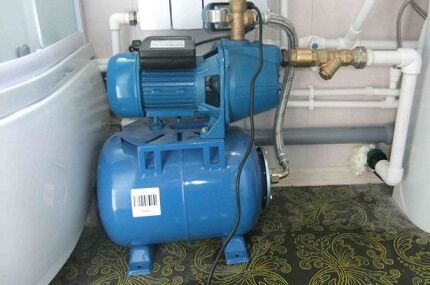
Installation principles for self-priming models
Installing a pump of this type is not particularly difficult. To do this, you will need approximately the same skills and tools that are needed to install other types of pumping equipment.
Schematically, the installation of a booster pump can be represented in the following steps:
- Choosing a location for the accumulator and pump.
- Installation of a hydraulic accumulator.
- Installation of pipes for connecting equipment to the water supply.
- Hanging the pump from the wall.
- Pump and accumulator piping.
- Checking the operation of equipment in automatic mode.
In essence, a pump and accumulator with a pressure switch is a variation pumping station. To implement the installation of such a system of devices, you first need to find a place to place the tank.
Some craftsmen replace the hydraulic accumulator with a membrane with an ordinary large capacity, for example, a 200-liter plastic tank.
Instead of a pressure switch, the tank is equipped float sensorto ensure it is automatically filled as needed. Such a tank is installed as high as possible: in the attic or on the top floor. You should immediately think not only about the size, but also about the configuration of the container.
The flat and narrow tank will take up less space than a traditional cylindrical model. Although there are no special requirements for the configuration of the container. When choosing a location for a container, you should provide access to the tank/hydraulic accumulator or the ability to easily dismantle this element. This is necessary to perform maintenance, repair or replacement of the device.
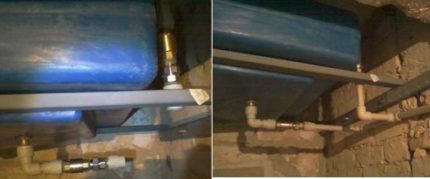
Hydraulic accumulators are supplied ready for installation, but the tank should be prepared. There are holes in it for water inflow and intake. You can also make a separate shut-off valve to drain the water in an emergency. The pipes for supplying water to the tank and taking it into the water supply system are mounted to one water pipe.
In modern conditions, it is more logical to use easy-to-install and reliable plastic pipes for installing water supply systems.
To prevent air from being sucked into the tank from the pump, and also to prevent water from entering there when the equipment is turned off, check valves should be installed on both pipes. After this, pipes are installed to connect the tank to the water supply system.
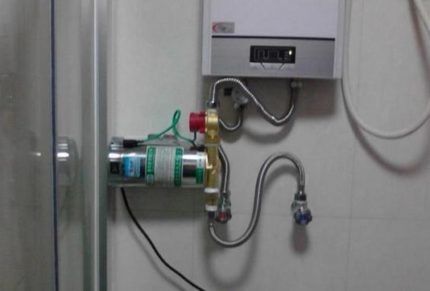
After the tank or hydraulic accumulator installed and the necessary water pipes have been laid, the installation of the suction pump can begin. Typically, such a device is supplied disassembled. It is first assembled and then installation begins.
If you decide to mount the pump on the wall, you should first make markings for the fasteners. The pump is then suspended and connected to the water supply pipes. Overall, this is not a very complicated operation. An important point is the direction of the fluid in the pump. It is indicated on the body with special marks.
The pump should be installed in such a way that the water flows from the tank to the water collection points. Thus, the installation and connection diagram for the pressure booster pump is as follows: hydraulic accumulator-pump-consumer. Then the pump is connected.
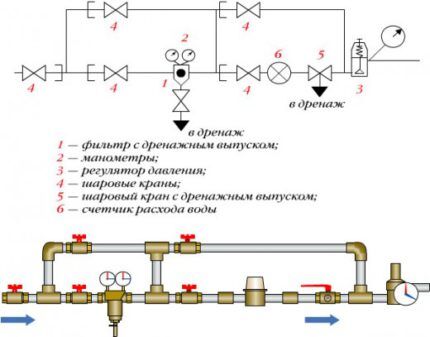
All connections must be carefully sealed. If threaded connections are used to connect the booster pump, a suitable sealant should be used: FUM tape, flax thread, etc.
The amount of sealant should be sufficient, but not excessive. The device is connected to plastic pipes using special fittings.
After this, you should check the operation of the entire system. If a tank with a float sensor was used, fill it with water. They check not only the operation of the sensor. The container that serves as a storage tank should be checked for leaks. If everything is in order, you can proceed to testing the operation of the pump itself.
The pump must be connected to the electrical network. It is recommended to move the pump switch lever to the position corresponding to automatic mode. All that remains is to open the nearest water tap and observe the operation of the device. If the installation is done correctly, the pump should automatically turn on and the water pressure will increase noticeably.
Pressure boosting circulation pumps are installed in a similar manner. A suitable place in the water supply is chosen for them, and they are inserted there. In this case, it is also extremely important to connect the pump correctly, taking into account the direction of fluid flow. If the position of the device is incorrect, the pump will still allow a flow of water.

But its work will be extremely ineffective, since the device simply will not function.The instructions and the housing indicate in detail the correct position of the pump.
After installation, the pump is connected to the electrical network and its operation is checked. If the water pressure at the nearest water intake point has increased, it means that the installation was completed correctly.
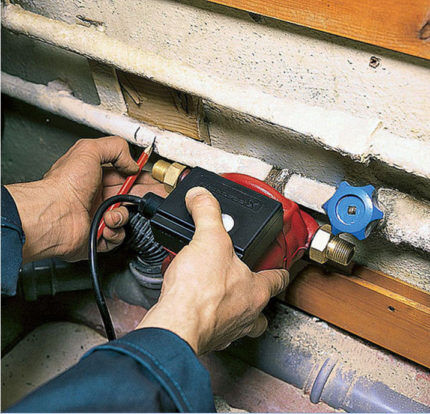
Installing a system with a hydraulic accumulator looks a little more complicated. First you need to understand the structure of the entire structure.
The pump is connected to the hydraulic accumulator using special hoses. Then a pressure switch is connected, with which the equipment will be turned on and off.
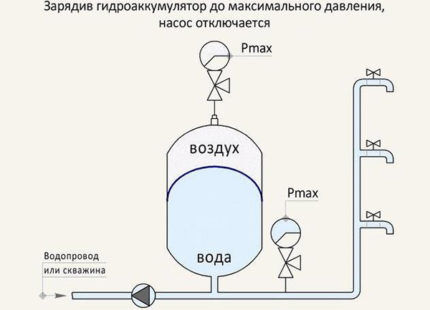
Deserves special attention relay setting. Before starting work, it is recommended to carefully study the instructions and recommendations of the manufacturer.
If the knowledge and skills for high-quality installation and configuration of equipment are not enough, it is better to contact a specialist for advice or completely entrust him with all the work.
Some useful tips
To solve a problem with low water pressure in a system, a booster pump is not always necessary. To begin with, it doesn’t hurt to diagnose the condition of the water pipes. Cleaning them or completely replacing them can restore normal pressure without additional equipment.
To understand that the problem is in the poor condition of the water pipes, sometimes it is enough to ask neighbors living in apartments on the same floor or above. If their pressure is normal, the pipes almost certainly need to be cleaned.
If the picture is the same for everyone, there may be more serious problems affecting the entire plumbing system of the house and even the area. In high-rise buildings, water sometimes simply does not reach the upper floors. This requires high-power and quite expensive equipment.
It makes sense to team up with other residents to share the costs. It is a good idea to demand a solution to the problem from the organization that receives payment for the water supply, since it is they who must ensure the supply of water to the consumer.
The lack of water on the upper floors is a violation of fire safety requirements. When communicating with a water supply service provider, it is worth paying attention to this point and mentioning the possibility of legal proceedings due to non-compliance with legal regulations.
It is best to entrust the installation of equipment in an apartment building to a full-time plumber of the management company. He is also better familiar with the system, and will be responsible in case of leaks or breakdowns caused by poor installation of equipment.
Conclusions and useful video on the topic
The operation of a booster pump in an apartment in a multi-storey building is clearly shown in the following video:
Educational video on installing a booster pump:
Many models of booster pumps can be easily installed independently. Even a novice plumber can cope with this task without any problems. But the level of comfort with normal water pressure in the system will increase very noticeably.
Interested in information or have questions? Please leave comments on the article and post thematic photos. Perhaps you have useful information in your arsenal that you are ready to share with site visitors.

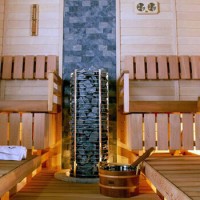
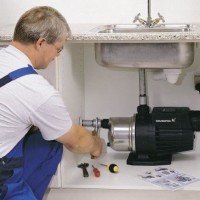

I live in a five-story building on the fifth floor, and I also encountered the fact that not only is there not enough water pressure in the water supply, but it simply simply does not reach my floor. No one could tell anyone who I asked about how to solve this problem. As a result, I found all the information myself and got confused with installing a centrifugal self-priming pump. Although it took a lot of sweat, it solved the problem.
Hello. If I were you, there was no need to spend money at all; it would have been better to ask the management company for non-compliance with water pressure standards.
We live in a village, on a hill. The water supplied from the center flowed terribly weakly from the tap. Plus, in winter, because there was little of it in the pipes, the house was very cold. Following the instructions of a friend, I installed a circulation pump for heating and a pumping station for needs. This has become enough for washing and for a gas water heater, but it is not possible to use everything at the same time.
Apartment on the 16th floor. If you install only a hydraulic accumulator without a pump, will it be of any use?
There will be no water at all.
A hydraulic accumulator is a plastic tank for collecting water. Without a pump it will work like this: you open the water, the tank fills. When you turn the tap to open, water will flow from the tank or from the tap, depending on what it is connected to. In the first case, the water will quickly run out (well, what kind of tank can be placed in the apartment) and it will be cold. In the second case, the accumulator will have no effect at all.
But! If you need a hydraulic accumulator to quickly fill a washing machine or dishwasher, then such a design solution is completely justified. The fact is that with poor water pressure in the pipes, the washing machine or dishwasher takes a long time to fill, and severe wear of the water intake elements occurs. When connected to a hydraulic accumulator, the device will take water from it and fill quickly, as at normal pressure.
Respect to the author, THANK YOU AND KEEP IT UP.
Good afternoon, we live in an apartment building on the 4th floor. We had a pump installed on our balcony to increase water pressure and a tank to collect water. The whole problem is that the horses turn off the lights in the house, and the water supply is turned off in general. Tell me, is this the pump not working correctly or does something need to be switched?
Hello. I have a few options, but it would be a good idea to know what kind of “water holding tank” you have. In general, first of all, it is necessary to check the pressure, the presence and functionality of the check valve, if the accumulator is the integrity of the membrane.
There is definitely a problem with the storage tank; for some reason, it does not take in water. There is another possible reason. For example, after a power outage, you used, for example, flushing the toilet and the water from the tank went to set the tank, electric boiler (if used), and so on.
I also have a task to increase the pressure in the water supply. In the country. But it is connected with the installation of a mixer with a heater. There is not enough pressure to turn on the heating element. Which pump is better to choose? Water comes from 100 l. tank. It is located behind the wall approximately 1 m above the mixer level. But the entry through the wall is made lower.
Since you already have a storage tank and a fairly large volume, you need to select an automatic pump that will increase the pressure in the water supply system to the required level.
As the optimal equipment in terms of price/quality ratio, I can recommend the pump for increasing water pressure Wilo-PB 088, which automatically turns on and off depending on the current water consumption. If this is expensive, then I can recommend a less expensive analogue - the Adriatika JET100L 1.1 kW centrifugal pump. The price of the first order is $100, and the second is $60. Wilo-PB 088 is made in North Korea, Adriatika JET100L is made in Poland.
oh those pumps from North Korea.
The instructions indicate that the pump must be installed either horizontally or with water supply from the bottom up. Is it possible to install it vertically, with water supply from above?
Hello. I do not think that the pump will work correctly if the instructions are not followed, where the manufacturer gives instructions regarding correct installation. In your case, it will be more profitable to buy several adapters, the necessary fittings and redo the wiring so that the water supply to the pump is according to the instructions. Believe me, this is not difficult to do, you will only spend an hour of time, but in the future there will be no problems during the operation of the pump.
If you don’t want to change anything in the current wiring, then change the pump to a model that requires water supply from above.
Nikolay, good afternoon. I live on the 1st floor of a 16-story building. A water pressure pump was installed under the bedroom in the basement.At night there is a low-frequency sound that is simply exhausting. Question - is it possible to move the pump 6 - 8 meters from the installed location to an adjacent room, which is located under the unwanted area, by extending the pipe?
Hello, Inna. You are heroically patient. You live in an apartment complex. You have a management company.
SP 51.13.330 2011 tab. 1, after clause 6.3 - included in the list of mandatory standards. Look at the table. 1, the maximum permissible noise values in different categories of buildings are indicated there. Write a statement to the management company so that they replace it, soundproof it, or do something else so that the pump does not exceed permissible standards. You yourself have no right to change anything. If they don’t want to, no one seems to have abolished Rospotrebnadzor and the housing inspectorate.
As I understand it, is this a general pump or your personal one?
«The power of a conventional circulation pump is low and it consumes less energy than some incandescent lamps. When it is included in the system, you can achieve an increase in pressure by about 2-3 atmospheres.»
Not a single “ordinary” circulation pump will raise the pressure to 2-3 atmospheres, even at zero flow. 1 atmosphere is the maximum, but even then, in the absence of water intake.
Hello! I installed a pump to increase the pressure, it works but it does not pump water. At the entrance there is sufficient pressure only on the 2nd floor there is no water, so I installed such a pump but it does not pump, what is my mistake?
Hello. I live on the 4th floor of a 5-story building. Water is supplied constantly in a shortened order so that it is pumped into the apartment extremely rarely and at night. There is often not enough pressure even to start the washing machine.
Please tell me which pump option will help in this situation. And please also recommend the optimal location for its installation (in the apartment or in the basement).
Hello Andrei. First of all, it is necessary to clarify that in your case you will need two pumps: one to increase the pressure in the system, and the second circulating. I also advise you to purchase a storage tank for water with a capacity of at least 100 liters. The most budget option is a plastic barrel.
As for pumps, from personal experience I can recommend Oasis, which has a pre-installed flow sensor. That is, you do not need to turn the pump on and off constantly, it will work automatically. The consumption of such equipment is only 120 W.
You need to install pumps and a reservoir directly in the apartment if you plan to increase the water pressure only for yourself.
Dear Nikolay, in my SNT pipes have been installed along the houses from several deep wells (100 meters) and those who wish can connect to this water supply. In summer, water consumption increases, pressure drops. What to do? Will a pressure increasing pump save the situation and which one? Thank you.
Good afternoon. A question. I live in a private house. Water is supplied to the house according to the following scheme: there is a hydraulic accumulator and a pressure switch that turns the deep pump on and off, water is supplied to the tank and from the tank to the house, but the pressure in the house changes and is unstable. Does it make sense to install another pressure booster pump already in the house to equalize the pressure and raise it?
Try to put it in front of the filter, the automatic air release certainly helped me, and when the filters are full, bleed the air, because there is oxygen when it runs out from the well, like soda.
Hello! I live on the 12th floor of a 12-story building. Constantly low cold water pressure. The plumbers diagnosed the problem and said that the cold water riser from the 8th to 12th floors needed to be replaced. The neighbors also suffer, but they don’t want to change. If I install a booster pump (not a system) at my place, will the pressure problem for my neighbors get worse? Will their pressure become less, or will this not affect them?
Hello
I live in a private house and installed a gas boiler, but the water pressure is only 1 bar
Could you tell me which pump to choose to raise the pressure to at least 2 bar?
which specific pump to choose to increase the pressure from 1.2 kg/cm2 at the inlet, the output should be 2.8-3.2 kg/cm2. Ideally. Water consumption is small, 1-1.2 m3/hour, switched on periodically by an external signal
Nikolay, good afternoon. Tell me how to solve the problem. A private house, a hundred-liter barrel stands at a level of one and a half meters from the floor, water is drawn almost from the bottom, a pressure-raising pump with a JEMIX flow sensor is installed. Everything was planned so that the dishwasher could work, but the pump does not turn on automatically, although when the tap in the sink is opened it works.
I understand that there is not enough flow, but I really don’t want to buy a station kit... maybe there are some options?
Hello, please tell me. We live in a private house, the cold water is centralized. At home, the pressure is weak, so it’s even impossible to wash in the shower; there’s no talk of installing a bathroom at all.The housing and communal services told us that we couldn’t plug the pump into the system, allegedly because of this there could be water outages for everyone in the village. Is it so?
Interesting
Good afternoon. Tell me which pumping unit to install in the basement of a high-rise building. On the top floor there is 1.2 kg missing. pressure, residents are not comfortable. Tell me what to consider?
Hello, the centralized water tank is located 300 meters from the site. I installed HDPE 3.2 pipe. There is low water pressure in the faucet. Please advise which pump should be installed to increase water pressure? We use water seasonally: spring - autumn.